Figure 4.1 Correct fitting of a trial frame with each pupil in the centre of each aperture, both horizontally and vertically.
Back vertex distance
Place a lens (of any value) in the trial frame. Ask the patient to fixate on a distant target, and use a rule to measure from the patient’s cornea to the back of the lens (the surface of the lens nearest the cornea). A normal BVD is 10 to 12 mm.
The power of a lens system depends upon the distance of the lens from the cornea. This concept is known as ‘lens effectivity’ and explains why a myope’s contact lens prescription will be numerically weaker than their spectacle prescription. It also explains why patients with powerful prescriptions get a blurred view when their spectacles slip down their nose.
Therefore, the BVD is important when a frame is to be constructed, since the function of the lens system depends not only on the lens power but also on the lens position relative to the cornea. Practically, this is relevant for prescriptions of more than 4 dioptres, but it is good practice to always record the BVD. Formulae exist to allow correction of any given prescription as well as BVD to a different prescription and BVD that will have an equivalent effect.
Visual acuity
‘Acuity’ is a measure of the resolving power of the eye – the ability to discriminate between two points. Distance charts that you should be comfortable with include the Snellen and the LogMAR. Near vision charts that you should be comfortable with include the N-series.
In any clinical setting, it is important to check the distance visual acuity for each eye (unaided, aided and pinhole) and the near acuity for each eye (unaided and aided). If aided, it is useful to state if this is with spectacles or contact lenses. The eye not being tested should be correctly occluded.
For the purpose of the exam, the patient’s spectacles will not be available, so the following will need to be established for each eye:
- distance acuity unaided (Snellen or LogMAR)
- distance acuity with pinhole
- near acuity unaided (N-series; remember to use a bright lamp).
Pinholes only allow axial rays through to the eye, hence reduce the effect of refractive error. Remember that the pinhole vision gives a good idea of potential vision for that eye once the refractive error has been corrected. Ideally, your target end-refraction visual acuity should be at least as good as the pinhole acuity.
Remember that eyes with reduced pinhole vision or reduced vision despite adequate refractive correction have acuity that is limited by amblyopia, ocular pathology or cerebral visual impairment. Pinhole acuity tends to partially improve with corneal or lens pathology but will not improve with amblyopia, retinal, nerve or cerebral pathology (pinhole acuity can be worse than unaided acuity in patients with macular pathology, since it precludes eccentric fixation).
Always consider – why is the vision poor?
Refractive error:
… improves with pinhole.
Amblyopia:
… no improvement with pinhole.
Ocular pathology:
… if of retina or nerve origin, will not improve with pinhole
… if of cornea or lens origin, may improve with pinhole.
Cerebral visual impairment:
… no improvement with pinhole.
Note, of course, a mixture of these reasons commonly coexist.
Refraction estimation
Checking the visual acuity will give you an idea of the refractive error:
- 1 dioptre of spherical error gives 6/12
- 2 dioptres of spherical error give 6/24 to 6/36
- 3 dioptres of spherical error give 6/60.
However, note that this guide is for spherical error and ignores that the patient may have astigmatism. The impairment in acuity is about half that for cylindrical errors relative to spherical errors. Therefore, a patient with 0.00/+2.00 @ 080 would be approximately 6/12 unaided.
This guide should only be used as an approximation, since patients will have a mixture of spherical and cylindrical error.
This refraction estimation alone does not, however, suggest whether the patient is myopic or hypermetropic. For example, if they are 6/24 unaided, their refraction could be –1.75 or +1.75 spherical dioptres. To estimate if the patient is myopic or hypermetropic, compare their unaided distance acuity with their unaided near acuity. This concept is more useful if the patient is presbyopic, since otherwise the effect of accommodation confounds the estimation. If a patient has poor distance vision but good near vision, you know they are myopic. For example, if a presbyope has an unaided Snellen distance acuity of 6/60, yet is N5 at reading distance (on the near vision N-series reading chart), their refraction is probably around –2.00 to –3.00 spherical dioptres.
If they have poor distance vision and poor near vision, you know they are hypermetropic (or they have amblyopia, or ocular pathology or cerebral visual impairment – this should be clear from your history).
Visual acuity testing of a child
Although children can be unpredictable, which adds stress to an examination setting since it is something you cannot control, there are a number of useful ways of handling this that come with experience in assessing the visual behaviour of children.
It is important to spend time with orthoptic staff, since this is the best way to learn to be comfortable with the following:
- patching as a means of occlusion (note that objection to occlusion implies poor acuity in the other eye)
- assessing if a child’s vision is central (i.e. no squint), steady (i.e. conjugate movements with no nystagmus) and maintained through the duration of a blink (i.e. there is sufficient acuity to fixate on and follow an object of interest, demonstrating that it is seen)
- preselected tests, such as Cardiff Cards, Kay Pictures, single optotype or crowded charts, used to assess binocular and monocular distance acuity.
Retinoscopy (objective refraction)
Retinoscopy basics
The aim of retinoscopy is to obtain an objective refraction – that is, an estimation of the patient’s spectacle prescription using a process that does not require any decisions to be made by the patient.
Retinoscopy also gives a good benchmark from which the prescription can be fine-tuned using subjective techniques (using subjective rather than objective refraction from the beginning takes considerably longer).
Retinoscopy is an invaluable process for children or adults with learning disability, as these patients will not be able to answer the questions required for subjective refraction. For these patients, your spectacle prescription will be based on your retinoscopy alone.
A retinoscope produces a light, which, with the cuff fully down, is linear (the scope slit). For more information on the retinoscope, see Appendix 2. Quite simply, the scope slit light is passed across the patient’s pupil and a light within the pupil (the reflex) is observed. By noting the quality of this reflex, various lenses are then placed in the trial frame to neutralise the reflex. As neutralisation is approached, the reflex will become faster and brighter. A dull, slow reflex implies neutralisation is not close. At neutralisation, the reflex is a glowing bright pupil; at this point, the lenses in the trial frame provide the objective spectacle prescription (once corrected for working distance).
The scope slit is held at a certain angle (say, vertically) then swept across the pupil in a direction perpendicular to the orientation of the scope slit (in this case, horizontally). As the scope slit passes across the pupil, the reflex can be noted to have certain characteristics: (a) direction, (b) orientation, and (c) brightness and speed.
Characteristics of retinoscope reflex
Direction:
- with or against or neutralised.
Orientation:
- vertical, horizontal or oblique
- scissor reflex.
Brightness and speed:
- bright and fast
- dull and slow.
Direction of reflex
A ‘with’ reflex is seen if, as your slit passes across the pupil, a light within the pupil (the reflex) moves in the same direction (see Figure 4.2). A plus lens must be added to the trial frame to approach neutralisation.
An ‘against’ reflex is seen if, as your slit passes across the pupil, a light within the pupil (the reflex) moves in the opposite direction (see Figure 4.3). A minus lens must be added to the trial frame to approach neutralisation.
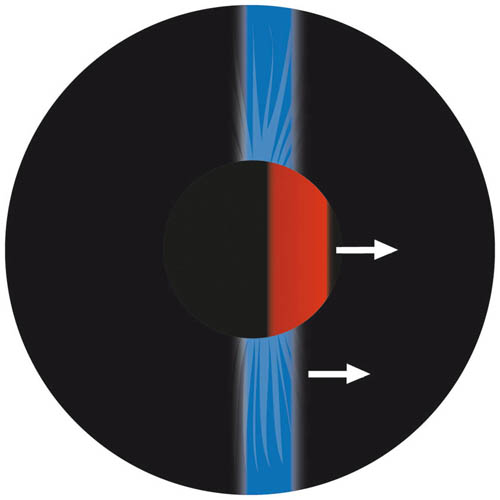
Figure 4.2 A ‘with’ reflex. The scope slit is orientated vertically and swept horizontally across the pupil to give a with reflex
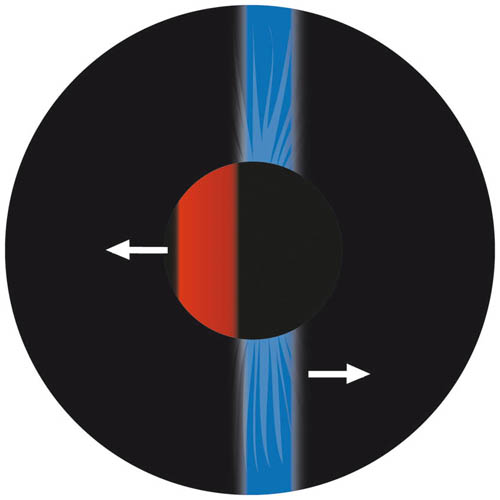
Figure 4.3 An ‘against’ reflex. The scope slit is orientated vertically and swept horizontally across the pupil to give an against reflex
To neutralise:
with reflex … add plus lens
against reflex … add minus lens.
Therefore, to approach neutralisation, either a plus (if with reflex) or minus (if against reflex) must be added to the trial frame. If the reflex is already quite fast and bright, only 0.25 or 0.50 may be sufficient to reach neutralisation. To confirm neutralisation, you can lean backwards, further away from the patient (reflex becomes against) or lean forwards closer to the patient (reflex becomes with). This is because the closer you are, the more minus must be added to correct for the working distance (see ‘Correction for working distance’, p. 34). Alternatively, to ensure the end point has been reached, add a +0.25 lens, which should give an against reflex. Such reversal of the reflex is important to achieve, since it highlights that the true end point of neutralisation has been established.
Note that the lenses added to approach neutralisation are either spherical or cylindrical. If a sphere is added to neutralise the reflex, it will also alter the subsequent lenses required in the perpendicular axis to obtain neutralisation. If a cylindrical lens is added (with the axis orientated the same way as the scope slit, so the power of the cylindrical lens will act in the same plane as the scope sweep), neutralisation in this plane is approached and has no effect on the other principal meridian.
Orientation of reflex
The orientation of the retinoscope’s slit light should be parallel to the pupil reflex.
If there is no astigmatism, or if the astigmatism is either with the rule or against the rule, the reflex will be orientated vertically and horizontally. In these situations, ensure the slit is vertical then horizontal (rotate the slit by rotating the cuff slightly) to neutralise these meridians.
With oblique astigmatism, the principal meridians are still perpendicular but do not lie vertically and horizontally. Therefore, when a horizontal scope sweep is made with the slit orientated vertically, the orientation of the pupil reflex will be oblique and not lie vertically (it will lie between 045 and 090 or 090 and 135) – see Figure 4.4. Similarly, if the scope slit was orientated horizontally and a sweep made vertically, the orientation of the pupil reflex will again be oblique and not be horizontal (it will lie between 000 and 045 or 135 and 180). For oblique astigmatism, the scope slit should be rotated by turning the cuff slightly so the slit is parallel to the pupil reflex to aid subsequent neutralisation. The perpendicular meridian can then be neutralised by rotating the slit 90 degrees (e.g. if one meridian is at 110, the other will be at 020).
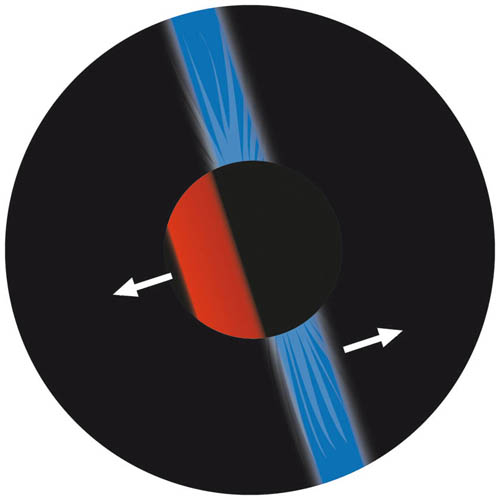
Figure 4.4 With oblique astigmatism, the orientation of the reflex will not be horizontal or vertical but oblique
Another type of reflex is the ‘scissor reflex’, which occurs with a high degree of irregular corneal astigmatism, such as keratoconus. These reflexes can be difficult or simply not possible to neutralise. Keratoconus is a corneal ectasia, characterised by progressive stromal thinning and conical distortion, associated with increasing irregular astigmatism and myopia. It is appropriate to examine the eye on the slit lamp for other signs of keratoconus (stromal thinning/cone, Vogt’s striae, Fleischer ring). Investigations include corneal topography so the degree of irregular astigmatism can be quantified and mapped. This aids the consideration of the various available treatment options for keratoconus, including contact lenses, scleral contact lenses or surgical intervention (riboflavin with ultraviolet A/collagen cross-linking, intra-stromal implants, deep lamellar or penetrating keratoplasty).
Brightness and speed of reflex
As mentioned, the brighter and faster the reflex, the closer to neutralisation. In these situations, use a small magnitude of lens power alteration (0.25 or 0.50 dioptres) since neutralisation is close.
Therefore, a dull, slow reflex is far from neutralisation and sometimes it pays to begin with a ±5 or ±10 spherical lens to start off with.
Remember, a dull reflex also occurs with medial opacity (such as with a cataract or vitreous haemorrhage). A dull reflex can also occur as a result of flat retinoscope batteries!
Correction for working distance
‘Working distance’ is the distance from the patient’s cornea to your retinoscope.
It is necessary to alter the sphere of the lenses in the trial frame to give a corrected full prescription based upon the value of the working distance.
The retinoscope is constructed so that if retinoscopy is performed at 1 m from the patient, the lenses in the trial frame to give neutralisation are equal to the spectacle prescription. However, we do not do retinoscopy at 1 m, but rather at 66 cm (when working with trial frames) or 50 cm (if you have shorter arms or when working without trial frames – for example, with children, examination under anaesthesia or a model eye). Therefore, once neutralisation is obtained, to convert to the corrected prescription, it is necessary to add a –1.50 sphere to the trial frame (to correct for a 66 cm working distance) or a –2.00 sphere (to correct for a 50 cm working distance). Note that the cyl remains unchanged.
Therefore, a –1.50 myope will neutralise without any lenses if working at 66 cm. A –2.00 myope will neutralise without any lenses if working at 50 cm.
Here are some other examples:
- neutralisation occurs with +4.25/–1.75 @ 030 at 66 cm, so the corrected refraction will be +2.75/–1.75 @ 030, since +4.25 plus –1.50 = +2.75
- neutralisation occurs with –3.75/+0.75 @ 044 at 50 cm, so the corrected refraction will be –5.75/+0.75 @ 044, since –3.75 plus –2.00 = –5.75.
Therefore, the working distance correction factor is the reciprocal of the working distance in metres and this must be subtracted from the retinoscopy result.
Whenever a result is recorded, it is vital to state whether this is uncorrected or corrected for the working distance and what that working distance is. Therefore, add a –1.50 spherical lens for a working distance of 66 cm and add a –2.00 spherical lens for a working distance of 50 cm.
The correction of working distance can be done at the end of the retinoscopy once neutralisation has been achieved, whilst working at 66 cm or 50 cm. However, it can be done at the start of retinoscopy. In this case, before using the retinoscope, you must add +1.50 (for 66 cm) or +2.00 (for 50 cm) to the trial frame (or your fingers, if working with no frame), and the resultant lens summation at neutralisation will give the corrected prescription. Whether you decide to correct for working distance at the end or the start of retinoscopy does not matter – but it must be done and your results should be clearly recorded to demonstrate at what stage a correction for working distance was made.
Static versus dynamic retinoscopy
‘Static’ retinoscopy means that the working distance is fixed throughout retinoscopy. This is what most practice and is what is detailed in this book.
Experienced practitioners can use the concept of working distance to their advantage by varying their working distance to obtain neutralisation (rather than changing the lenses). This is known as ‘dynamic’ retinoscopy.
For example, an emmetrope neutralises at 1 m, a –1.50 myope at 66 cm, a –2.00 myope at 50 cm, a –5.00 myope at 20 cm and so on. Imagine you get an against movement at 66 cm – rather than adding a minus lens (in the case of static retinoscopy), you instead lean forward to 50 cm and neutralisation occurs – the patient’s refraction in that meridian is therefore –2.00.
Dynamic retinoscopy is less practical for hypermetropes, since hypermetropes neutralise with a working distance of more than 1 m.
Dynamic retinoscopy takes considerable practise but is extremely useful for refracting challenging patients (such as children) because it is so rapid.
Retinoscopy technique
Ideally, the room should be dim. The darker the room, the easier it is to note the reflex characteristics; if the room is too dark, you will struggle to find your lenses. A useful trick is to use your retinoscope light as a torch if you cannot see the lens markings easily.
Ensure that your retinoscope cuff is all the way down on the shaft of the retinoscope.
Key points for retinoscopy
- Establish a dim room.
- Fog (or occlude, if necessary) the fellow eye.
- Scope the patient’s right eye with your right eye/right hand.
- Scope the patient’s left eye with your left eye/left hand.
- Keep your scope as close as possible to their visual axis, without interrupting continuous distant fixation.
- Correct for working distance (add –1.50 sphere if at 66 cm; add –2.00 sphere if at 50 cm).
- Record in either positive cyl notation for both eyes or negative cyl notation for both eyes (never positive for one eye and negative for the other).
The first step is to examine the patient’s right eye with the retinoscope. For non-cycloplegic refraction of patients who are not presbyopic (especially if they are myopic), it is necessary to fog (blur) the fellow left eye. This involves placing a +1.50 or +2.00 spherical lens on top of the presumed refraction (estimated from their acuity, which you have just checked), so that the acuity is poorer than that of the eye being examined with the retinoscope.
Adequate fogging can be confirmed by ensuring that the retinoscopy reflex is against or, alternatively, checking the acuity in each eye with the fog in place and ensuring the fogged eye has poorer acuity than the eye about to be objectively refracted. If the patient is 6/6 with the presumed refraction, a +1.50 or +2.00 spherical dioptre fog typically renders the eye to 6/12 to 6/24.
The reason why the fellow eye should be fogged is to reduce accommodation, which would give a false result when examining the fellow eye with the retinoscope. With cycloplegic refraction (typically in children), there is no need to fog, since the accommodative component is removed by the cycloplegia. For non-cycloplegic refraction (most adults), fogging is required to reduce any accommodative drive (especially if the patient is a myope who is not yet presbyopic).
This fogging induces less accommodation than simple occlusion with a black occluder – hence, the effort made to fog rather than simply occlude.
Occlusion, rather than fogging, should be avoided, as it stimulates more accommodation. However, occlusion is required in the following situations:
- when the eye being tested is densely amblyopic (since the eye not being tested must have a poorer acuity to help avoid accommodation and a +2.00 lens will probably be insufficient to achieve this)
- if the patient markedly objects to fogging due to diplopia or asthenopia
- if you are unable to estimate acuity and provide an adequate fog lens.
Once you have adequately fogged (or, if necessary, occluded) the fellow eye, ask the patient to fixate on the white light or green target in the distance. Explain to them that it is important that they continue to look into the distance and not at your own white light. Ask them to let you know if your head obscures their view of the distant fixation target. It is vital to ensure that your head is as close as possible to their visual axis, without actually obscuring their distant fixation target – this ensures that your retinoscope light will be close to their visual axis (see Figure 4.5). Failure to be ‘on axis’ in this way can result in spurious astigmatism, thus it is important to be wary of this when refracting children who shift their position.
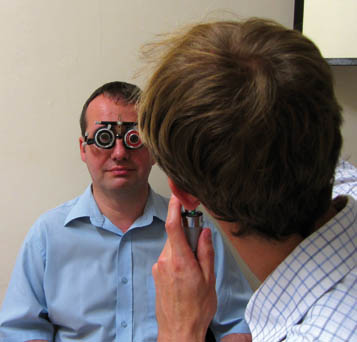
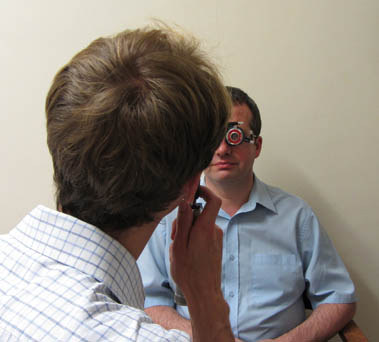
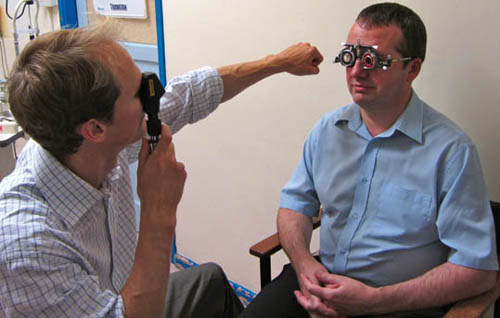
Figure 4.5 Use your left hand to perform retinoscopy of the patient’s left eye (left photo), since incorrectly using your right hand will obstruct their view (central photo). Check working distance with arm (right photo).
Use your right hand and right eye to scope their right eye. Scope first with a vertical, then a horizontal and finally a diagonal slit to locate the principal meridians. If only a dull, slow reflex is seen, try using a ±5 or even a ±10 lens. Then proceed by refracting in plus or minus cyls or spheres alone (see ‘Working in plus/minus cyls or spheres’, p. 39).
Once you have objectively refracted the right eye, correct for your working distance (add a –1.50 sphere if at 66 cm) and record your result (state ‘corrected for working distance’). Then fog the right eye and use your left hand and left eye to scope their left eye. Once you have objectively refracted the left eye, again correct for working distance and record this. You should now turn the lights on, check the visual acuity and move onto subjective refraction.
Remember that if a with reflex is seen, then a plus lens should be added and if an against reflex is seen then a minus lens should be added to approach neutralisation. The brighter and faster the reflex, the closer you are to neutralisation (the entire pupil lights up when the slit enters the pupil), whereas a dull and slow reflex implies you are not close to neutralisation.
Working in plus/minus cyls or spheres
It is possible to refract with your retinoscope in three different ways:
- using positive cyls
- using negative cyls
- using spheres only.
Using positive cyls
This means that your retinoscopy result will be in a plus cyl format.
Identify the orientation of the two principal meridians, which will be perpendicular to each other. The principal meridian that has an against reflex – or, if both reflexes are with, it will be the least with reflex (which is fastest and brightest, as it is nearest neutralisation) – is neutralised first with spheres. This will result in the other principal meridian giving a with reflex, which is then neutralised with positive cyls (the axis on the lens in the same orientation as the scope slit). The resultant prescription will be the lenses in the trial frame (which must then be corrected for working distance).
For example, you identify an against reflex with scope slit at 135 and a with reflex at 045. Add minus spheres until the against reflex at 135 is neutralised (say, –3.00 causes neutralisation). Then add plus cyls (with the axis in the same orientation as the scope slit at 045) to neutralise the with reflex (say, +1.50 at 045 causes neutralisation). The axis line on the cyl lens should be parallel to the scope slit and light reflex (perpendicular to its power). The lenses in the trial frame then give the retinoscopy result in plus cyl format: –3.00/+1.50 @ 045, which must then be corrected for working distance (if at 66 cm, this gives –4.50/+1.50 @ 045).
This may sound complicated, but simply consider that a patient with regular astigmatism requires a sphere with a cyl superimposed upon it to correct their refractive error. The sphere is found by neutralising the most against reflex, and the perpendicular meridian will then give a with reflex, which can be neutralised with plus cyls to give the sphero-cylindrical correction (which must be corrected for working distance).
Using negative cyls
This means that your retinoscopy result will be in a minus cyl format.
Identify the orientation of the two principal meridians, which will be perpendicular to each other. First, neutralise the most with reflex with plus spheres then neutralise the perpendicular against reflex with minus cyls. The lenses in the trial frame will give the retinoscopy result in minus cyl format, which must then be corrected for working distance.
Using spheres only
It is possible to obtain an objective refractive result without using any cylindrical lenses. Identify the two principal meridians. Neutralise one of the meridians with a sphere, record the result and orientation of reflex then remove the sphere. Following this, neutralise the perpendicular meridian with a sphere and record the result and orientation of the reflex. The refractive result can then be expressed in either plus or minus cyl format; in both cases, the magnitude of the cyl is the difference between the two spheres. It can be useful to use a power cross to generate the resultant prescription.
Power crosses
As noted, if working in plus or minus cyls, the resultant refraction obtained by retinoscopy will simply be the lenses in the trial frame (this does not apply if working in spheres). This can then be corrected for working distance.
Therefore, it is not necessary to draw power crosses and power crosses are not required for the Refraction Certificate Examination (at the time of writing). However, since some practitioners use power crosses it is good practice to understand them. Furthermore, if you work only in spheres, it is useful to use a power cross to obtain your resultant refraction.
Each arrowed arm of a power cross represents the direction of movement of the retinoscope sweep. For example, when sweeping horizontally with the scope slit orientated vertically, the power in the horizontal plane (180) is examined. Therefore, if a sphere with power +3.50 dioptres neutralises a horizontal sweep, this implies the power in the horizontal direction is +3.50 dioptres. If a sphere with power +2.00 dioptres is then required to neutralise a vertical sweep with a horizontally orientated scope slit (to assess vertically acting power), the resultant power cross would be:

Correcting for working distance would give:
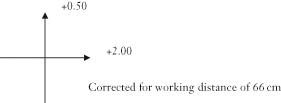
To obtain the prescription from the power cross in positive cyl notation:
- record the least positive sweep as the sphere
- record the cyl as the difference between the two sweeps
- record the axis as the same axis of the most positive sweep (remembering that the axis is perpendicular to the direction of action of the power arrow).
Stay updated, free articles. Join our Telegram channel

Full access? Get Clinical Tree


